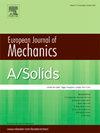轧制304不锈钢合金的Johnson和Cook损伤和流动应力模型参数
IF 4.2
2区 工程技术
Q1 MECHANICS
引用次数: 0
摘要
以往对304不锈钢合金(SS 304)的研究主要集中在变形诱发马氏体体积分数与外加应变和应变速率之间的应力-应变行为。虽然同样重要,但到目前为止,这种合金的失效/断裂尚未得到彻底的研究。在本研究中,对高应变速率(2900 s−1)下有效的轧制ss 304合金的Johnson和Cook (JC)损伤模型参数进行了实验确定,并与JC流变应力参数一起进行了数值验证。合金的拉伸破坏应变随应变速率从10−3到10−1 s−1和2900 s−1的增加而减小。实验还发现,当应变大于0.2时,在2900 s−1处的流动应力低于1 × 10−3 s−1处的流动应力,这是由于绝热加热降低了应变增大时马氏体相变的延伸。利用准静态和高应变率拉伸试验数值模型的结果,进一步标定了确定的损伤和流变应力模型参数。对未测试和测试样品的显微分析和硬度测量证实了马氏体相变,并且在1 × 10−3 s−1的测试样品中发现了最高的硬度值。计算了马氏体体积分数随应变率的变化直至约颈缩应变(均匀变形),并利用电子背散射衍射(EBSD)对不同应变率下的试样进行了显微测定。结果表明,在10−3 s−1应变速率下,试样的马氏体体积分数最高(0.55 ~ 0.6),在高应变速率下,试样的马氏体体积分数最低(0.27 ~ 0.30)。计算结果与EBSD测定的马氏体体积分数吻合。本文章由计算机程序翻译,如有差异,请以英文原文为准。
The Johnson and Cook damage and flow stress model parameters of a rolled stainless steel 304 alloy
Previous studies on stainless steel 304 alloy (SS 304) have mostly focused on the stress-strain behavior as function of the volume fraction of deformation induced martensite and the applied strain and strain rate. Although equally important, the failure/fracture of this alloy has not been thoroughly investigated so far. In the present study, the Johnson and Cook (JC) damage model parameters of a rolled-SS 304 alloy, valid at a high strain rate (2900 s−1), were experimentally determined and numerically validated along with the JC flow stress parameters. The tensile failure strain of the alloy decreased as the strain rate increased from 10−3 to 10−1 s−1 and to 2900 s−1. Experimentally lower flow stresses at 2900 s−1 than at 1x10−3 s−1 were also found at the strains above 0.2, which was attributed to the adiabatic heating that declined the extend of the martensitic transformation at increasing strains. The determined damage and flow stress model parameters were further calibrated with the results of the numerical models of the quasi-static and high strain rate tension tests. Microscopic analyses and the hardness measurements on the untested and tested specimens confirmed the martensitic transformation and the highest hardness values were found in the specimens tested at 1x10−3 s−1. The martensite volume fraction as function strain rate until about necking strain (homogeneous deformation) was calculated and also microscopically determined using the electron back-scatter diffraction (EBSD) for the specimens tested at different strain rates. The results indicated the highest martensite volume fraction in the specimens tested at 10−3 s−1 (0.55–0.6) and the lowest in the specimens tested at the high strain rate (0.27–0.30). An agreement between the calculated and the EBSD determined martensite volume fractions was shown for the studied alloy.
求助全文
通过发布文献求助,成功后即可免费获取论文全文。
去求助
来源期刊
CiteScore
7.00
自引率
7.30%
发文量
275
审稿时长
48 days
期刊介绍:
The European Journal of Mechanics endash; A/Solids continues to publish articles in English in all areas of Solid Mechanics from the physical and mathematical basis to materials engineering, technological applications and methods of modern computational mechanics, both pure and applied research.

 求助内容:
求助内容: 应助结果提醒方式:
应助结果提醒方式:


